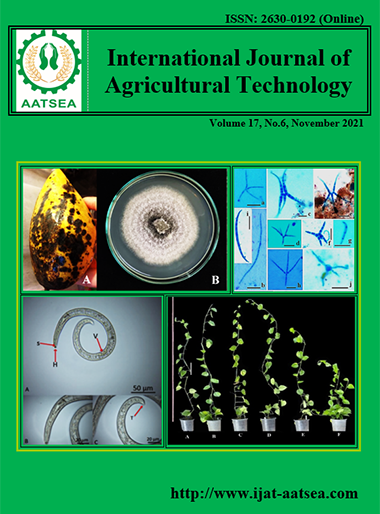The inhibition of seed germination treated with water extract of sorghum (Sorghum bicolor, L.) cultivated in Histosols
Main Article Content
Abstract
Allelopathy is a form of suppressing plant growth due to the release of toxins into the surrounding plants. Sorghum (Sorghum bicolor, L.) is a plant producing an allelopathic compound. Abiotic stress to sorghum planted in Histosols can determine the allelochemical release process. Application of an aqueous sorghum extract can control weeds nearby the main crop. The inhibition of seed germination treated with water extract of sorghum grown in marginal lands (Histosols) with different pattern of water application is determined. A watering pattern consisted of wet, alternate of a week wet and dry pattern, alternate of a week dry and wet pattern, dry and Ultisols (as a control). The concentration of root water extract of sorghum consisted of 0.0%, 2.5%, 5.0%, 7.5%, 10.0%, 15.0%, 20.0%, and 25.0%. The results showed that the highest inhibition of sorghum seed germination was under 7.5-10% concentration of water extract at dry Histosols as indicated by the lowest plumula and radicle fresh and dry weight. This finding indicated that drought stress sorghum in Histosols produces the highest allelopathic compound. Therefore, the plant has the potential as a source of bioherbicides.
Article Details

This work is licensed under a Creative Commons Attribution-NonCommercial-NoDerivatives 4.0 International License.
References
Araniti, F., Miras-Moreno, B., Lucini, L., Landi, M. and Abenovoli, M. R. (2020). Metabolomic, proteomic and physiological insights into the potential mode of action of thymol, a phytotoxic natural monoterpenoid phenol. Plant Physiology and Biochemistry. In Publish.
Asadi, M. and Eshghizadeh, H. R. (2021). Response of sorghum genotypes to water deficit stress under different CO2 and nitrogen levels. Plant Physiology and Biochemistry, 158:255-264.
Bing, Y., Yu-fei, Z., Ming-yue, G., Zhuang, Z., Yi, H., Guang-dong, Y., Wenjuan, X. and Rui-dong, H. (2014). Effect of drought stress during flowering stage on starch accumulation and starch synthesis enzymes in sorghum grains. Journal of Integrative Agriculture, 13:2399-2406.
Cheema, Z. A. and Khaliq, A. (2000). Use of sorghum allelopathic to control weeds in irrigated wheat in a semi arid region of Punjab. Agriculture, Ecosystems and Environment, 79:105-112.
Cluzet, S., Merillon, J. M. and Ramawat, K. G. (2020). Specialized metabolites and plant defence. In Plant Defence Biological Control Second Edition (Ed: Merillon M and Ramawat KG). Springer.Springer Nature Switzerland.
Correia, N. M., Centurion, M. A. P. and Alves, P. L. C. (2005). Influence of sorghum aqueous extracts on soybean germination and seedling development. Ciencia Rural, 35.
Darmanti, S. (2018). Review Interaction of allelopathy and allelochemicals compound its potential as bioherbicide. Buletin Anatomi dan Fisiologi, 3:181-187.
Farooq, M., Khan, I., Nawaz, A., Cheema, M. A. and Siddique, K. H. M. (2013). Using sorghum to suppress weeds in autumn planted maize. Crop Protection, 133:105162. https://doi.org/10.1016/j.cropro.2020.105162
Glab, L., Sowinski, J., Bough, R. and Dayan, F. E. (2017). Allelopathic potential of sorghum (Sorghum bicolor (L.) Moench) in weed control: a comprehensive review. Advances in Agronomy, 145:43-94.
Iannuci, A., Fragasso, M., Platani, C., Narducci, A., Muillo, V. and Papa, R. (2012). Dynamics of release of alleochemical compound from roots of wild oat (Avena fatua L.). Agrochemica, 56:185-192.
Inderjit and Keating, K. I. (1999). Allelopathy:principles procedures, processes and promises for biological control. Advances in Agronomy, 67:141-231.
Maqbool, N., Wahid, A., Farooq, M., Cheema, Z. A. and Siddique, K. H. M. (2013). Allelopathy and abiotic stress interaction in crop plants. Springer. Heidelberg, 451-468.
Moosavi, A., Tavakkol, A. R., Asadi, A. and Gharineh, M. H. (2011). Alleopathic efeects of aquenous extract of leaf stem and root of Sorghum bicolor on seed germination and seedling grwoth of Vigna radiata L. Notulae Scientia Biologicae, 3:114-118.
Sowiński, J., Dayan, F. E., Glab, L. and Sowinska, K. A. (2020). Sorghum allelopathy for sustainable weed management. In Plant Defence Biological Control Second Edition (Ed: Merillon M and Ramawat KG). Springer.Springer Nature Switzerland.
Susilo, E., Setyowati, N., Nurjannah, U., Riwandi and Muktamar, Z. (2020). Effect of swamp iirigation pattern and sorghum extract concentration on sorghum seed sprout. Proceeding of the 3rd KOBI Congress, International and National Conferences (KOBICINC), 14:19-25.
Weston, L. A. and Czarnota, M. A. (2001). Activity and persistance of sorgoleone, a long-chain hydroquinone produced by sorghum bicolor. Journal of Crop Production, 4:363-377.


